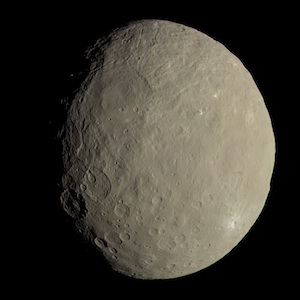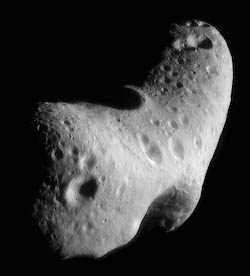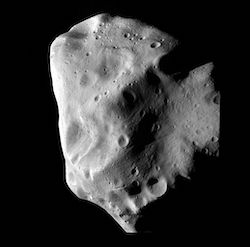Many people think of asteroids as being small chunks of rock that drift aimlessly and randomly through space. The reality, of course, is a little different, but it wasn’t until relatively recently that we began to discover more about them. For example, we now have a better idea of their origins and their composition.
Asteroids are the leftovers from the formation of the solar system. The planets came together about 4.6 billion years ago, with the rocky planets forming closest to the Sun. The asteroid belt, between Mars and Jupiter, is the remains of a planet that failed to form, most likely due to the gravitational interference of Jupiter. Most asteroids can be found there, although some can also be found in other locales within the solar system.

The first asteroid was discovered on January 1st, 1801. Officially known as 1 Ceres, it has a diameter of 974km and is the largest known asteroid. (The smallest known asteroid is only six feet across, but others could be smaller.)
As of August 2020, there are a little over 990,000 known asteroids. In theory, anyone can discover an asteroid, with the discoverer having the honor of being able to name it after almost anyone they desire. Traditionally they were named for gods and goddesses (like the planets themselves) but nowadays they could be named for scientists, politicians, writers, actors or musicians.
We know asteroids are rocky in nature, but not all rock is the same. Bouncing radar signals off asteroids as they pass by the Earth can provide clues to their composition and, therefore, their type.
There are three main groups, based upon the composition of the asteroid:
- C – Chondrite, clay and silicate rocks
- S – Stony, silicate materials and nickel-iron
- M – Metallic, nickel-iron
While other types exist, these three account for over 90% of the known asteroids in our solar system.
C-Types, the Carbon Asteroids

C-type asteroids are also known as carbonaceous, or chondrite asteroids. The most common type, they account for about 75% of all known asteroids and predominantly occupy the outer portion of the asteroid belt.
The asteroid belt itself occupies the area between Mars and Jupiter that’s roughly 2 AUs to 3.5 AUs from the Sun, with one AU being the approximate distance between the Earth and the Sun. (Mars orbits at roughly 1.5 AUs while Jupiter lies at an average distance of 5.2 AUs)
In comparison, C-type asteroids orbit near the very edge of the outer portion of the belt, at a distance of 3.5 AUs from the Sun. Roughly 80% of all the asteroids found there are C-types, compared to just half that amount at 2 AUs.
The temperature is too cold at the edge of the belt for the heat of the Sun to have affected their composition, leaving the rocks in much the same state as they were when they first formed. As a result, they are some of the oldest objects in the solar system
Perhaps it’s not surprising then, that these asteroids have a very similar composition to the Sun and the nebula from which the solar system was born. They could therefore provide important clues as to how the solar system formed.
One other noteworthy aspect of chondrite asteroids is that they’re primarily made up of carbon, and are quite dark as a result. In fact, a C-type asteroid only reflects about 3% of the sunlight that strikes it (compared to about 32% for the Earth.)
The largest known chondrite is 10 Hygiea, while the brightest is 324 Bamberga (the numbers indicate the order in which they were discovered.)
S-Types, the Stony Asteroids

The second most common type, stony asteroids account for about 17% of all known asteroids. Most of the asteroids found in the inner asteroid belt – at a distance of about 2.2 AUs from the Sun – are S-types, but they can also be found in the middle of the belt, at around 3 AUs from the Sun.
Stony asteroids are primarily comprised of a metallic nickel-iron and magnesium silicate mixture and are brighter than their more common C-type cousins. Specifically, they reflect about 20% of the Sun’s light, with the brightest being visible in binoculars. The asteroid 7 Iris is the brightest of this type, and the second brightest asteroid overall.
(The brightest asteroid, 4 Vesta, is a V-type, one of the more unusual types that account for less than 10% of the total asteroid population.)
S-types are also typically larger than most, with the largest – 15 Eunomia – being roughly 330km in diameter.
M-Types, the Metallic Asteroids
M-type asteroids are typically found around the middle of the asteroid belt. They account for most of the rest of the known asteroids, and while the composition of some M-types is unknown, they’re thought to be primarily comprised of nickel-iron. Some also contain small amounts of stone.

The composition of these asteroids can vary, depending upon their distance from the Sun when they formed. It’s possible that those that formed closer to the Sun, where temperatures are higher, may have partially melted, causing iron to sink to the center and lava to rise to the surface.
The largest of these, 16 Psyche, is one of the most massive asteroids in the solar system and is thought to be the iron core of a protoplanet. It’s theorized that the protoplanet lost its outer, rocky crust in a collision with another object. The Psyche space probe, due to launch in August 2022, will encounter the asteroid in 2026 and spend nearly two years studying it.
Like S-types, these asteroids are relatively bright and reflect between 10%-18% of the sunlight they receive.
No matter what their type, most asteroids only ever appear as faint, starlike points with ground-based telescopes. Despite their stellar appearance from this distance, these rocks may hold the key to unlocking the secrets of how our solar system – including the Earth itself – may have formed. And once the Psyche probe reaches its destination, we might start to learn a whole lot more.
